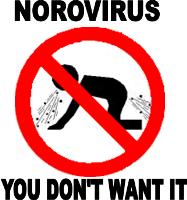Katie Overbey, an MS student studying food science at NC State writes,
The Internet is a hub for oversharing, and nothing seems to be off limits, including vomit.
Check out these Twitter hashtags from recent school outbreaks of norovirus: #RHSplagu, and #DSSplague2014. RHS is Richardson High School in Texas, where norovirus sickened about 600 people this past January. The second hashtag is from Delta Secondary School in Canada, where about 300 people came down with norovirus in June. Some common  themes from these hashtags are updates on the progression of the virus, concerns about missing school, various plans for trying to not get sick and discussions about vomit. Don’t have your vomit fix? Do a search of #norovirus on Twitter and for even more fun try #vomit.
themes from these hashtags are updates on the progression of the virus, concerns about missing school, various plans for trying to not get sick and discussions about vomit. Don’t have your vomit fix? Do a search of #norovirus on Twitter and for even more fun try #vomit.
Besides providing hours of entertainment and the occasional cringe, why should people care about broadcasting their bodily functions for the world to see?
Researchers are demonstrating that the symptom-sharing provides a signal to aid in identifying outbreaks. All those seemingly TMI posts about people’s evenings spent on the toilet could actually be predicting norovirus outbreaks sooner than any lab test. New York City Health Department has been using Yelp reviews that mention food poisoning or norovirus to find outbreaks and gather more details about them. Chicago has a Twitter account, @foodbornechi, for people to tweet about their foodborne illnesses.
Last year, the U.K. Food Standards Agency (FSA) embarked on a social media listening project that, it hopes, has the potential to predict outbreaks of the winter vomiting bug, norovirus, earlier than ever before.
FSA’s social media team sifted through Twitter data from the last norovirus outbreak during the winter of 2012-13, hunting for spikes in certain related key words and phrases being used in tweets. They then compared the frequency of the key words to the number of lab reports of confirmed norovirus cases in the same period.
They found significant correlations between spikes in the number of lab reports and spikes in conversations on Twitter using words and hashtags such as #winterbug, #norovirus, sickness bug, winter virus and vomiting.
What’s more, they discovered a set of symptom keywords, such as #barf, #flu, chuck up, puke, retch and upset stomach, which strongly correlated to future lab cases.
FSA stated some caveats though, – People self-diagnose. Symptom keywords and search terms are broad so “there’s always going to be a bit of noise”. And early warnings of an outbreak will increase chatter around the subject and might skew the data.
Exploring the use of Twitter for disease detection is promising and could allow health officials to disseminate information earlier and potentially control the spread of norovirus.
